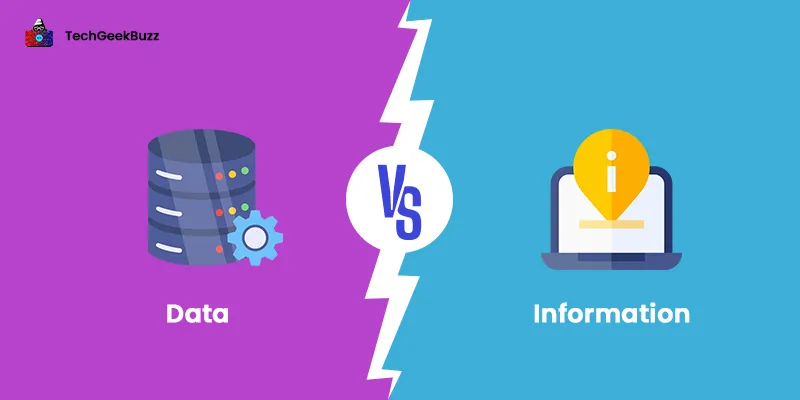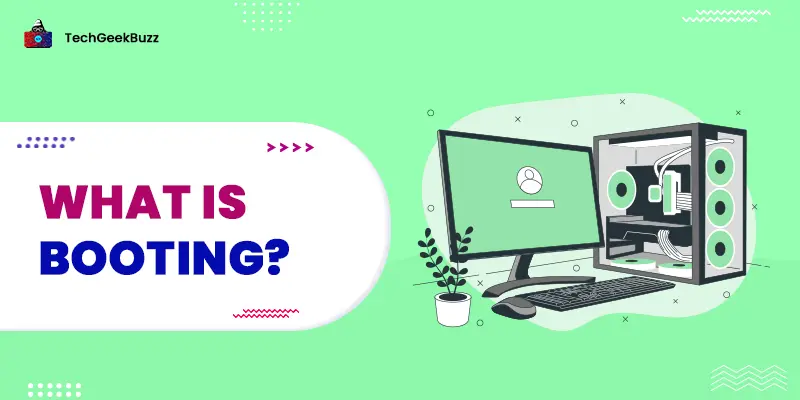In today’s digital era, data, and information have become the lifeblood of businesses, helping them make informed decisions. Both are common terms, and we use them synonymously in everyday life. However, there are many fundamental differences between data and information.
Think of data as an area filled with scattered jigsaw pieces and information as an expert mapper who puts all those jigsaw pieces together to form a meaningful map.
Hence, we can say that data is scattered or individual facts, whereas information refers to the organization and interpretation of those facts. In other words, information refers to putting data into context.
In the business world, both data and information are valuable and indispensable assets driving growth and innovation. Let us now dive deeper into the difference between data and information without any delay.

What is Data?
Data is a collection of raw and unorganized facts, details, or statistics. It is available in different formats, such as figures, text, observations, descriptions, etc. Common examples of data include individual prices, weights, temperatures, names, ages, addresses, etc.
Well, data has no significance itself or does not have any purpose, as it is raw or incomprehensible. It needs to be processed to generate something meaningful out of it. Without analyzing and processing, data seems to be unuseful and meaningless.
Hence, we can say that data is simply a collection of facts or statistics used for reference or analysis.
Another basic definition of data in computing is the individual units of information. In computing devices, the data is represented in the form of bits and bytes. In analytical processing, data is represented as a variable.
In order to extract meaningful insights from data, it is analyzed and interpreted either by humans or machines.
Data is categorized into two types, as follows:
- Quantitative data: This data can be anything that you can measure easily. We often refer to it as numerical data. The weight, volume, age, price, etc., are examples of quantitative data.
- Qualitative data: It is non-numerical data and describes the quality or characteristics of an attribute. Name, eye color, gender, etc., are examples of qualitative data.
Characteristics of Data

- Raw and Unprocessed: Data is raw and disordered and does not have any meaning or context of its own. It simply collects figures, statistics, and facts in their original form.
- No Objective: Data does not have any purpose or significance of its own until it undergoes processing and interpretation.
- Immutable: It is impossible to modify data without adding new inputs or observations.
- Quantitative or Qualitative: We can represent data in numbers (quantitative) as well as in text, images, audio, and videos (qualitative).
What is Information?
Information is the insight or knowledge gained from analyzing and interpreting the pieces of data. It is the result obtained from processing raw data and provides knowledge and insights that humans easily understand. It is represented in the desired context and has significance and a specific purpose.
Unlike data, information is organized and structured. It reduces uncertainty and makes data more reliable and useful. It answers several questions, provides explanations, and serves as the basis for making informed decisions.
Information is crucial to making valuable decisions in different aspects of life, including education, science, research, and business. When it comes to research, information helps discover new knowledge. It serves as an asset in the business landscape, assisting companies in making strategic decisions.
Characteristics of Information

- Processed Data: Information is the processed raw data that provides relevance, context, and meaning.
- Contextual: It is related to a certain context and serves a specific purpose.
- Comprehensible: Humans can quickly grasp information (knowledge or insights) and use it in decision-making.
- Actionable: Information is actionable and practical, and it is useful in the problem-solving process.
- Summarized: Information highlights key insights from the processed data. Hence, it is summarized and concise.
- Dynamic: It keeps updating continuously as new data is processed.
Difference Between Data and Information - A Head-To-Head Comparison
The following table highlights the difference between data and information:
|
Data |
Information |
|
Data is a collection of unorganized and unrefined facts that have no meaning on their own. |
Information is processed data with meaning and context. It is a refined and organized form of data. |
|
It is an individual unit of information and contains raw materials without any meaning. |
It is a group of data that collectively carries logical meaning. |
|
Data is independent of information. However, it is dependent on the sources from where it is gathered. |
Information entirely depends on the collected data. |
|
Raw or unprocessed data is not useful for making decisions. |
Processed data or information is useful for making decisions. |
|
Data is in the form of figures, statistics , tables, trees, flowcharts, and graphs. |
Information is in the form of thoughts, ideas, languages, and views. |
|
There is no context and purpose to data. |
Information has a particular meaning and serves a purpose. |
|
We measure data in bits or bytes. |
We measure information in meaningful units, such as time, quantity, etc. |
|
Data acts as an input to extract meaningful information. |
Information acts as an input for making actionable decisions. |
|
It is valuable for data analysis . |
It is valuable for making informed choices. |
|
An example of data is every student’s total test score. |
An example of information is the average test score of a class derived from data. |
Data vs Information: Examples
Example 1:
Consider a restaurant that collects the details from every customer. The details of customers are simply the collection of unorganized facts called data. Information is one when the restaurant leverages those unorganized facts to determine the most popular and least popular dishes.
The derived information from raw data helps the restaurant to focus more on the most popular dish and make it better to improve customer satisfaction.
Example 2:
Consider a set of temperature readings of a specific location over a period of time. Individual temperature readings have no meaning or context; hence, we refer to them as data.
However, this data turns into information when we organize those temperature values and process and analyze them to determine seasonal temperature patterns or climate trends.
From the above examples, we can conclude that when the data is organized and processed so that it provides some value to the audience, we refer to it as information.
Let us look at other examples to understand the difference between data and information.
|
Data Examples |
Information Examples |
|
The number of visitors to a website in a month. |
Analyzing the number of visitors to a website per month and determining the increase or decrease in monthly visitors. |
|
Inventory levels in a warehouse on a particular day. |
Collecting the data of inventory levels in a warehouse for multiple days and identifying the supply chain issues based on the patterns of the inventory levels over time. |
|
Satisfaction score from an individual customer in a service survey. |
Utilizing satisfaction scores from all customers and determining the areas of improvement to make customer service better. |
|
The product price offered by competitors |
Identifying whether competitors are charging less or more for a certain product. |
Data vs Information: Key Differences
The following is the list of the key differences between data and information:
- Data is raw, unprocessed, and unorganized, while information is processed and organized.
- Data is a collection of facts. Conversely, information refers to putting these facts into context and extracting meaningful insights.
- When data is analyzed, processed, and interpreted, it becomes information.
- On its own, data is meaningless and not useful. Information is knowledge that provides specific meaning and serves a purpose.
- Information is entirely dependent on data, while data is not dependent on information.
- Data is generally in the form of figures, statistics, numbers, or graphs. On the other hand, information is always represented in the form of thoughts, words, and ideas.
- Information is useful for making decisions, while data is not.
Conclusion
This was all about the difference between data and information. While data is unprocessed, unstructured, and unorganized, information is organized, processed, and structured. Data has no meaning or purpose until it is processed, while information has. In fact, the result of the processed data is information itself. Hence, without data, it is not possible to extract information or knowledge to be used in decision-making.
We hope this article has enlightened you on the significant differences between data and information. If you want to add any other differences, feel free to share them in the comments.
People are also reading:


![What is an Assembler? [Definition, Working, & Types]](/media/new_post_images/What_is_Assembler.jpg)
![What is I/O? [Types, Examples, & Methods]](/media/new_post_images/What_is_I_O.webp)

Leave a Comment on this Post